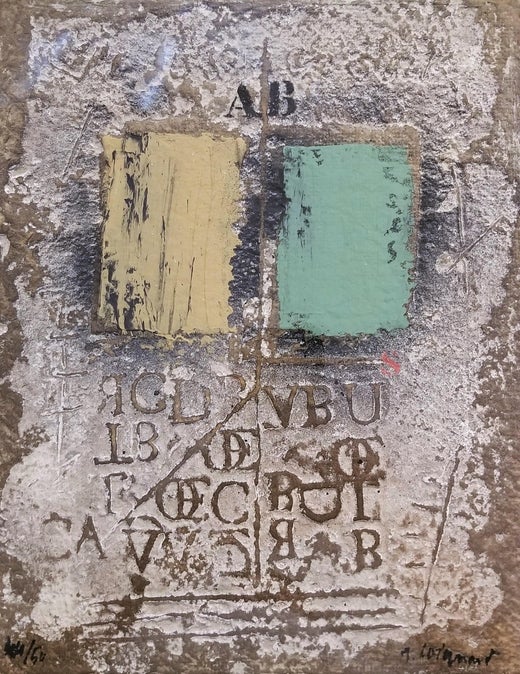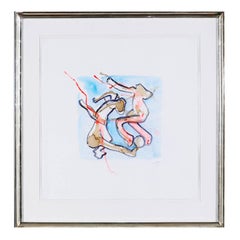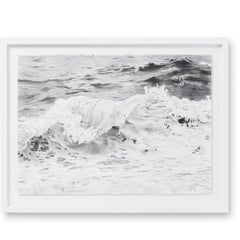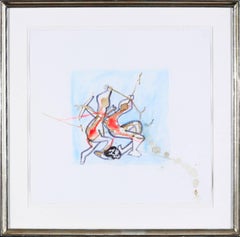Want more images or videos?
Request additional images or videos from the seller
1 of 5
James CoignardTrois bleus en diagonale.2005
2005
Price:$1,000
$1,184.12List Price
About the Item
- Creator:James Coignard (1925-2008, French)
- Creation Year:2005
- Dimensions:Height: 10.63 in (27 cm)Width: 13.39 in (34 cm)
- Medium:
- Movement & Style:
- Period:
- Condition:
- Gallery Location:Malmo, SE
- Reference Number:1stDibs: LU3281906903
James Coignard
James Coignard, painter, ceramist, sculptor and etcher, was born in Tours in 1925. At the age of 23 and after a brief career in the French administration, he discovers the landscapes of the French Riviera and decides to study at Arts décoratifs in Nice. Four years later, he quits his job at the administration to commit himself entirely to his artistic career. The encounter with Paul Hervieu in 1950 is decisive. His collaboration with gallery Hervieu made him known in artistic circles, nationally and internationally and then particularly in Scandinavia. At the beginning of his career, art critics label James Coignard as a member of Ecole de Paris. Soon, his painting and ceramic distances themselves from those of his colleagues and he goes it alone. At the beginning of the sixties, he starts to work with glass but the technical turning point occurs in 1968 when his friend Henri Goetz discovers a new etching technique, using carborundum. Etching then becomes central in his work. At the same time, his career takes off internationally. He travels a lot, especially to Sweden and USA where he lives during a few years. 1978, James Coignard participates in the creation of the etching studio Pasnic, with which he starts a long collaboration. During the eighties, he shares his time between Paris and the French Riviera and takes an interest in artist’s books and publishing issues. He exhibits now all over the world, and is acknowledged as one of the greatest painter-etchers of his time. Until his decease in 2008, James Coignard was a prolific painter, sculptor and etcher and leaves behind an immense work.
About the Seller
5.0
Vetted Professional Seller
Every seller passes strict standards for authenticity and reliability
Established in 1967
1stDibs seller since 2013
240 sales on 1stDibs
Authenticity Guarantee
In the unlikely event there’s an issue with an item’s authenticity, contact us within 1 year for a full refund. DetailsMoney-Back Guarantee
If your item is not as described, is damaged in transit, or does not arrive, contact us within 7 days for a full refund. Details24-Hour Cancellation
You have a 24-hour grace period in which to reconsider your purchase, with no questions asked.Vetted Professional Sellers
Our world-class sellers must adhere to strict standards for service and quality, maintaining the integrity of our listings.Price-Match Guarantee
If you find that a seller listed the same item for a lower price elsewhere, we’ll match it.Trusted Global Delivery
Our best-in-class carrier network provides specialized shipping options worldwide, including custom delivery.You May Also Like
Floreos
By Mark Lembo
Located in Boston, MA
About the piece:
Floreo, "Flower" in Spanish, has special meaning in flamenco dance.
Words that describe this piece:outsider, intuitive, blue, monochrome, dynamic, action, flamenco, movement
Artist Biography:
Mark A. Lembo Script M Abstract Art Mark’s dynamic work blurs the distinction between alcohol ink and watercolor - working with dyes, inks, liquid acrylic, liquid watercolor, and other aqueous media; lately, he has been incorporating metallic watercolor and pearlescent ink to his work. He has used canvas, synthetic Yupo™ paper, Yasutomo Mineral Paper, and various watercolor papers. Mark’s journey into the world of creative arts started with the question, “What would Jackson Pollock’s work look like if he had used transparent watercolors?” So, it was out with the pencils, pens, and brushes, and on to the pouring of various aqueous solutions. While mostly self-taught, Mark took a series of classes at the Creative Arts Group, Sierra Madre, CA, under Joe Stoddard, as well as seminars with Robert...
Category
21st Century and Contemporary Abstract Abstract Drawings and Watercolors
Materials
Mixed Media, Watercolor, Synthetic Paper
No Bronze
By Mark Lembo
Located in Boston, MA
About the piece:
26H x 20W
Metallic watercolor and pearlescent ink on Yupo
Limited series - size and materials
2021
Taking the 'Wash Buckle' series to new heights (and widths...
Category
21st Century and Contemporary Abstract Abstract Drawings and Watercolors
Materials
Mixed Media, Synthetic Paper
Fractured Toon
By Mark Lembo
Located in Boston, MA
About the piece:
Happy accident(s). Chaos amid the order?
Words that describe this piece:panels, comics, structure, chaos, cartoon
Artist Biography:
Mark A. Lembo Script M Abstract Art Mark’s dynamic work blurs the distinction between alcohol ink and watercolor - working with dyes, inks, liquid acrylic, liquid watercolor, and other aqueous media; lately, he has been incorporating metallic watercolor and pearlescent ink to his work. He has used canvas, synthetic Yupo™ paper, Yasutomo Mineral Paper, and various watercolor papers. Mark’s journey into the world of creative arts started with the question, “What would Jackson Pollock’s work look like if he had used transparent watercolors?” So, it was out with the pencils, pens, and brushes, and on to the pouring of various aqueous solutions. While mostly self-taught, Mark took a series of classes at the Creative Arts Group, Sierra Madre, CA, under Joe Stoddard, as well as seminars with Robert Burridge...
Category
21st Century and Contemporary Abstract Abstract Drawings and Watercolors
Materials
Paper, Watercolor, Mixed Media
Rollerskate
By Mark Lembo
Located in Boston, MA
About the piece:
- Mixed aqueous media on Yupo synthetic paper. Pairs well with 'Skateboard'.
- Single white mat 14H X 18W
Words that describe this piece:abstract, primary, dynamic...
Category
21st Century and Contemporary Abstract Abstract Drawings and Watercolors
Materials
Mixed Media, Watercolor, Synthetic Paper
Working Blue 03
By Mark Lembo
Located in Boston, MA
About the piece:
Texture emphasized over complicating the palette.
Single White Mat 18Hx14W
Words that describe this piece:intuitive, abstract, minimalist, minimal. blue
Artist Biography:
Mark A. Lembo Script M Abstract Art Mark’s dynamic work blurs the distinction between alcohol ink and watercolor - working with dyes, inks, liquid acrylic, liquid watercolor, and other aqueous media; lately, he has been incorporating metallic watercolor and pearlescent ink to his work. He has used canvas, synthetic Yupo™ paper, Yasutomo Mineral Paper, and various watercolor papers. Mark’s journey into the world of creative arts started with the question, “What would Jackson Pollock’s work look like if he had used transparent watercolors?” So, it was out with the pencils, pens, and brushes, and on to the pouring of various aqueous solutions. While mostly self-taught, Mark took a series of classes at the Creative Arts Group, Sierra Madre, CA, under Joe Stoddard, as well as seminars with Robert Burridge...
Category
21st Century and Contemporary Abstract Abstract Drawings and Watercolors
Materials
Mixed Media, Synthetic Paper
(Grey) Patches
By Mark Lembo
Located in Boston, MA
About the piece:
Representative of the (Grey) series. A little drier application of media upon a thinner Canson colored paper.
Appearing at the 32nd Annual Cool Art Show, July 24-...
Category
21st Century and Contemporary Abstract Abstract Drawings and Watercolors
Materials
Mixed Media, Paper
Working Blue 01
By Mark Lembo
Located in Boston, MA
About the piece:
Recently started experimenting with single color palette and emphasizing texture.
Single White Mat 18Hx14W
Words that describe this piece:intuitive, Minimalist, m...
Category
21st Century and Contemporary Abstract Abstract Drawings and Watercolors
Materials
Mixed Media, Synthetic Paper
SHIZEN SERIES I
By Kim Fonder
Located in Tulsa, OK
Kim Fonder, SHIZEN SERIES I, Mixed Media on Handmade Paper with Plexi, 12.00 X 12.00 in, $600.00, Blue
White, Abstract, works on paper
Kim Fonder loves texture and touch. Her painti...
Category
2010s Abstract Mixed Media
Materials
Plexiglass, Mixed Media, Handmade Paper
SHIZEN SERIES V
By Kim Fonder
Located in Tulsa, OK
Kim Fonder, SHIZEN SERIES V, Mixed Media on Handmade Paper with Plexi, 12.00 X 12.00 in, $600.00, Blue
Abstract, contemporary, White, mixed media, fine art
Kim Fonder loves texture ...
Category
2010s Abstract Mixed Media
Materials
Plexiglass, Mixed Media, Handmade Paper
ENSO CIRCLE
By Lisa Weiss
Located in Tulsa, OK
ENSO CIRCLE by Lisa Weiss is a Mixed Media on Bhutanese Paper measuring 12.00 X 9.00 in and is priced at $360.00.
Lisa Weiss’ work is about mark making, patterning, spontaneous move...
Category
2010s Abstract Mixed Media
Materials
Mixed Media, Handmade Paper
More From This Seller
View AllFoot Musik.
By Roberto Matta
Located in Malmo, SE
Pastel, gouache and coffee on paper.
Artwork size: 58 x 56 cm.
Frame size: 78 x 76 cm.
Free shipment worldwide.
Acquired directly from the artist.
Archive number (P90/37)
“The heart is an eye,” writes Nobel laureate Octavio Paz in an essay on Matta’s paintings. Matta creates a world coloured both by a sunny faith in the future and by visions of impending doom.
Roberto Sebastian Echaurren Antonio Matta, who died aged 91 on 23 November 2002, was born in Santiago, Chile, on 11 November 1911 into a family with Spanish, French and Basque roots, and raised in an atmosphere of religiosity. By the age of 21 he had graduated and begun work as an architect, but his leisure time he devoted to sketching and painting. In 1933 he travelled to Europe for the first time, visiting Greece, Yugoslavia, Italy and other countries, and subsequently taking the initiative to collaborate with the architect, Le Corbusier. As time passed, however, Matta’s enthusiasm for a career in architecture waned, and he began to devote himself full-time to art, making early acquaintances with surrealists such as Max Ernst, Salvador Dalí, André Breton and others.
Between 1939 and 1948 Matta, like many of his artistic contemporaries, lived in self-imposed exile in the USA, but, after almost 10 years’ absence from Europe, he returned to make first Rome and then, a few years later, Paris his home. Throughout most of the rest of his life Matta commuted between his studio in Paris and his creative refuge in the monastery outside Rome. And it is here, in Italy, that he produced his greatest paintings.
Matta’s first retrospective in Sweden was organised in 1956 when his works were exhibited in what was then Galerie Colibri – run by, among others, the artist C O Hultén at number 36 Södra Förstadsgatan in Malmö, Sweden. This was also the time when Matta began to collaborate with poets and other artists in Sweden. He produced the illustrations for Lasse Söderberg’s first anthology of poems, Akrobaterna (“The Acrobats”), published in 1955, and was also responsible for the cover of the Swedish art and literary magazine Salamander.
In 1959 the first museum exhibition of Matta’s work in Europe was arranged at the Museum of Modern Art (Moderna Museet) in Stockholm. Held under the aegis of Pontus Hultén, it was entitled “Fifteen Forms of Doubt” and included 15 or so gigantic paintings...
Category
1990s Abstract Mixed Media
Materials
Mixed Media
Le jour se lève
By Philippe Huart
Located in Malmo, SE
Signed, titled and dated on the verso.
Acquired directly from the artist.
Free shipment worldwide.
Working on a variety of perceptual levels, Philippe Huart lets one visit his intim...
Category
2010s Abstract Abstract Drawings and Watercolors
Materials
Paper, Pen, Graphite
Foot Musik
By Roberto Matta
Located in Malmo, SE
Artwork size: 56 x 58 cm.
Frame size: 76 x 78 cm.
Free shipment worldwide.
Archive number (P90/36)
Acquired directly from the artist.
“The heart is an eye,” writes Nobel laureate Octavio Paz in an essay on Matta’s paintings. Matta creates a world coloured both by a sunny faith in the future and by visions of impending doom. Roberto Sebastian Echaurren Antonio Matta, who died aged 91 on 23 November 2002, was born in Santiago, Chile, on 11 November 1911 into a family with Spanish, French and Basque roots, and raised in an atmosphere of religiosity. By the age of 21 he had graduated and begun work as an architect, but his leisure time he devoted to sketching and painting. In 1933 he travelled to Europe for the first time, visiting Greece, Yugoslavia, Italy and other countries, and subsequently taking the initiative to collaborate with the architect, Le Corbusier. As time passed, however, Matta’s enthusiasm for a career in architecture waned, and he began to devote himself full-time to art, making early acquaintances with surrealists such as Max Ernst, Salvador Dalí, André Breton and others. Between 1939 and 1948 Matta, like many of his artistic contemporaries, lived in self-imposed exile in the USA, but, after almost 10 years’ absence from Europe, he returned to make first Rome and then, a few years later, Paris his home. Throughout most of the rest of his life Matta commuted between his studio in Paris and his creative refuge in the monastery outside Rome. And it is here, in Italy, that he produced his greatest paintings. Matta’s first retrospective in Sweden was organised in 1956 when his works were exhibited in what was then Galerie Colibri – run by, among others, the artist C O Hultén at number 36 Södra Förstadsgatan in Malmö, Sweden. This was also the time when Matta began to collaborate with poets and other artists in Sweden. He produced the illustrations for Lasse Söderberg’s first anthology of poems, Akrobaterna (“The Acrobats”), published in 1955, and was also responsible for the cover of the Swedish art and literary magazine Salamander. In 1959 the first museum exhibition of Matta’s work in Europe was arranged at the Museum of Modern Art (Moderna Museet) in Stockholm. Held under the aegis of Pontus Hultén, it was entitled “Fifteen Forms of Doubt” and included 15 or so gigantic paintings...
Category
1990s Surrealist Abstract Drawings and Watercolors
Materials
Mixed Media
Foot Musik
By Roberto Matta
Located in Malmo, SE
Frame size 76x78 cm.
Free shipment worldwide.
Acquired directly from the artist.
Archive number (P90/41)
“The heart is an eye,” writes Nobel laureate Octavio Paz in an essay on Matta’s paintings. Matta creates a world coloured both by a sunny faith in the future and by visions of impending doom.
Roberto Sebastian Echaurren Antonio Matta, who died aged 91 on 23 November 2002, was born in Santiago, Chile, on 11 November 1911 into a family with Spanish, French and Basque roots, and raised in an atmosphere of religiosity. By the age of 21 he had graduated and begun work as an architect, but his leisure time he devoted to sketching and painting. In 1933 he travelled to Europe for the first time, visiting Greece, Yugoslavia, Italy and other countries, and subsequently taking the initiative to collaborate with the architect, Le Corbusier. As time passed, however, Matta’s enthusiasm for a career in architecture waned, and he began to devote himself full-time to art, making early acquaintances with surrealists such as Max Ernst, Salvador Dalí, André Breton and others.
Between 1939 and 1948 Matta, like many of his artistic contemporaries, lived in self-imposed exile in the USA, but, after almost 10 years’ absence from Europe, he returned to make first Rome and then, a few years later, Paris his home. Throughout most of the rest of his life Matta commuted between his studio in Paris and his creative refuge in the monastery outside Rome. And it is here, in Italy, that he produced his greatest paintings.
Matta’s first retrospective in Sweden was organised in 1956 when his works were exhibited in what was then Galerie Colibri – run by, among others, the artist C O Hultén...
Category
1990s Surrealist Drawings and Watercolor Paintings
Materials
Mixed Media, Gouache
SF 89-153.
By Sam Francis
Located in Malmo, SE
Artwork size: 67 x 51 cm.
Frame size: 112 x 97 cm.
Free shipment worldwide.
Archive number SF 89-153 in the Sam Francis Foundation.
Stamped with the Sam Francis Estate logo and stamped signature on verso.
Sam Francis’s paintings are a journey into a dream, a voyage into the landscapes of the soul where colours are lights on fire.
Alongside names such as Jackson Pollock, Willem de Kooning and Franz Kline, Sam Francis is an artist who has succeeded in demonstrating a total mastery of abstract expressionism’s impassioned and spontaneous genre.
The explosions of colour – red, blue, green and yellow – the streaks, strokes and bold lines of his pictures are the physical synthesis of the deepest crevices of the soul. His colours create rhythmical motifs that, characteristically enough, can be called the “musicality” of his paintings.
The work of Sam Francis provides a visible meeting place for the conscious and the unconscious. His pictures are the cross-fertilisation of what has already been experienced with what exists still only as desire, a struggle between melancholy and merrymaking.
Influenced by C.G. Jung, the father of psychoanalysis, Sam Francis spent a large portion of his life exploring the premise that dreams, instincts and intuition provide, the keys which unlock the mysteries and meaning of our inner lives. He was also fascinated by the four ancient elements – earth, water, air and fire – which developed into a leitmotif in his work.
Sam Francis was born in San Mateo in California, USA in 1923. After starting to paint at the age of around twenty, he soon found himself increasingly consumed by the power of art.
He spent much of the 1950s in Paris, from where he not only made frequent excursions to a number of European cities, but also embarked on many journeys to South America and Asia.
He continued to move from place to place, primarily in the USA and Japan, right up until his death in 1994.
Sam Francis’s first...
Category
1980s Contemporary Abstract Paintings
Materials
Paper, Acrylic
Riguer bleue
By James Coignard
Located in Malmo, SE
Published by edition GKM.
Unframed.
Edition: 40 ex.
Signed by the artist.
Free shipment worldwide.
“With just a few strokes of his brush he conjures up an entire world. James Coignard extends the boundaries between concrete and abstract. He knows how to create chromatic melodies that shift in timbre from cobalt blue to blood red. His pictures are an artistic epicentre where lines, letters and numbers meld with vigorous swashes of colour.” That is how the writer Johan Persson has described the artist’s paintings. With this exhibition we honour James Coignard, showing some of his last carborundum engravings and paintings as well as presenting the book “L’œuvre gravé de James Coignard” volume VI. In this edition, we have gathered together all the engravings that James Coignard produced between June 2005 and his decease, on 7 March 2008. Behind him he left many fond memories and a life’s work as a great artist. James Coignard’s principal modes of expression were oil on canvas and gravure au carborundum, but also in bronze and glass sculptures as well as in ceramics. His work has been shown on more than 400 exhibitions, primarily in Central Europe and Scandinavia, but also in Canada and the USA. His first Swedish exhibition was at Malmö Museum in 1956. The early 1970s saw the start of a long-term liaison with Galleri Östermalm in Stockholm, owned by Editions Sonet. They came to represent him in Scandinavia and edited several volumes of his graphic works. It was not until 2003 that we at Galleri GKM Siwert Bergström...
Category
Early 2000s Abstract Prints and Multiples
Materials
Engraving
Recently Viewed
View AllMore Ways To Browse
Blue Abstract Canvas Oil Big Size
Emmanuelle Simon
Louis Vuitton Hommage
Louis Vuitton Jacket First Copy
Luz Camino
Manon Steyaert
Manuel Valdes
Marcus Manganni
Mark Bennion
Mark Sloper On Sale
Maxim Wakultschik
Meredith Nemirov
Mexican Cock Fight
Mexican Straw Art
Michael Callas
Michele Cossyro
Mitja Tusek
Nail And String Art




